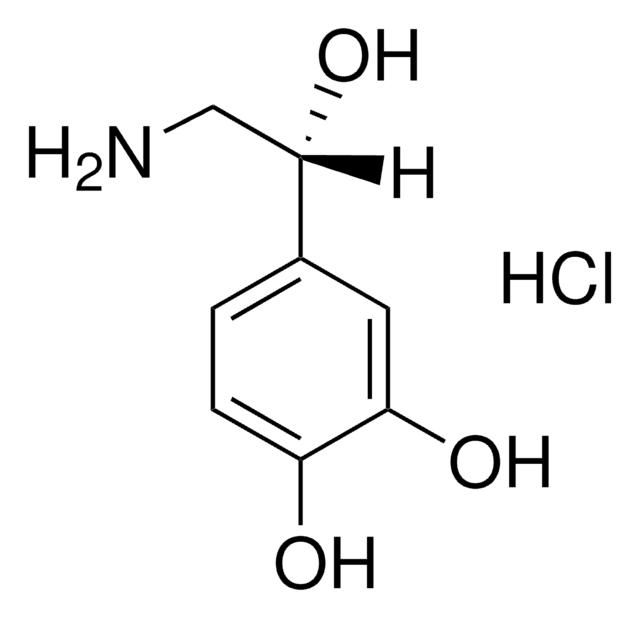E4642
(±)-Epinephrine hydrochloride
≥98% (TLC), powder, adrenergic receptor agonist
Synonyme(s) :
(±)-Adrenalin, 4-(1-Hydroxy-2-[methylamino]ethyl)-1,2-benzenediol hydrochloride
About This Item
Produits recommandés
product name
(±)-Epinephrine hydrochloride,
Niveau de qualité
Solubilité
H2O: 50 mg/mL
Température de stockage
2-8°C
Chaîne SMILES
OC(CNC)C1=CC=C(O)C(O)=C1.Cl
InChI
1S/C9H13NO3.ClH/c1-10-5-9(13)6-2-3-7(11)8(12)4-6;/h2-4,9-13H,5H2,1H3;1H
Clé InChI
ATADHKWKHYVBTJ-UHFFFAOYSA-N
Informations sur le gène
human ... ADRA1A(148) , ADRA1B(147) , ADRA1D(146) , ADRA2A(150) , ADRA2B(151) , ADRA2C(152) , ADRB1(153) , ADRB2(154) , ADRB3(155)
Vous recherchez des produits similaires ? Visite Guide de comparaison des produits
Description générale
Application
- in the induction of renalase expression in Human renal proximal tubular epithelial cells
- in the infusion studies to test its effect on heart rate and eye temperature measurements in bull
- as a medium supplement for the stimulation of endothelial progenitor cells
Actions biochimiques/physiologiques
Mention d'avertissement
Danger
Mentions de danger
Conseils de prudence
Classification des risques
Acute Tox. 3 Dermal - Acute Tox. 3 Oral - Eye Irrit. 2 - Skin Irrit. 2 - STOT SE 3
Organes cibles
Respiratory system
Code de la classe de stockage
6.1A - Combustible acute toxic Cat. 1 and 2 / very toxic hazardous materials
Classe de danger pour l'eau (WGK)
WGK 3
Point d'éclair (°F)
Not applicable
Point d'éclair (°C)
Not applicable
Équipement de protection individuelle
Eyeshields, Faceshields, Gloves, type P2 (EN 143) respirator cartridges
Certificats d'analyse (COA)
Recherchez un Certificats d'analyse (COA) en saisissant le numéro de lot du produit. Les numéros de lot figurent sur l'étiquette du produit après les mots "Lot" ou "Batch".
Déjà en possession de ce produit ?
Retrouvez la documentation relative aux produits que vous avez récemment achetés dans la Bibliothèque de documents.
Les clients ont également consulté
Notre équipe de scientifiques dispose d'une expérience dans tous les secteurs de la recherche, notamment en sciences de la vie, science des matériaux, synthèse chimique, chromatographie, analyse et dans de nombreux autres domaines..
Contacter notre Service technique











